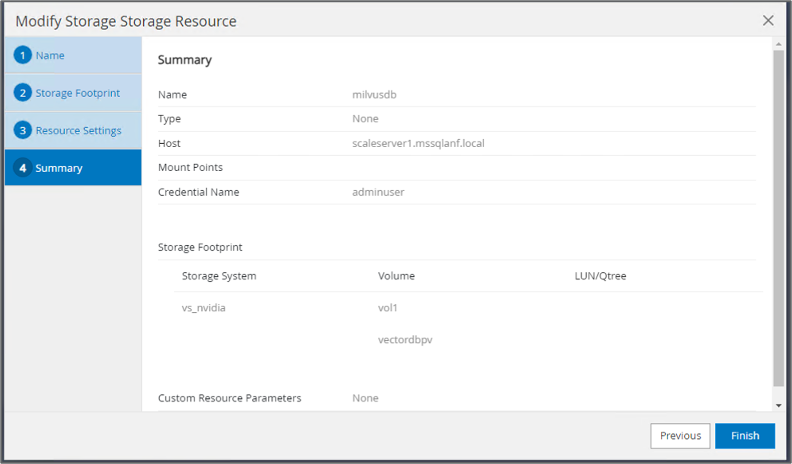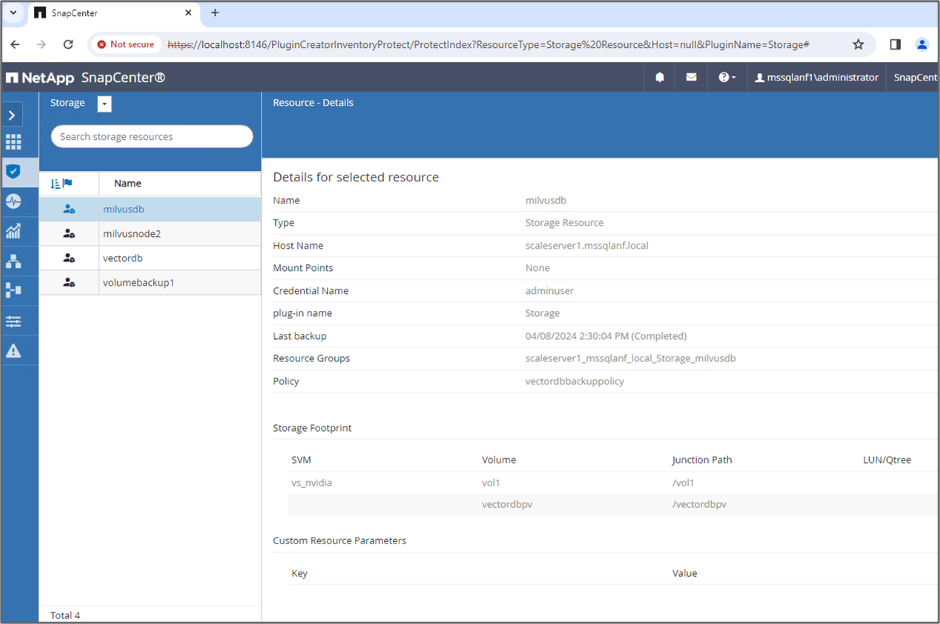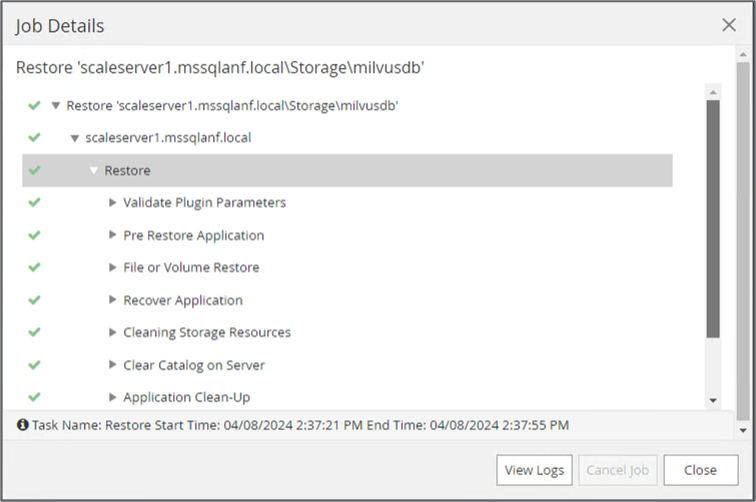使用SnapCenter进行矢量数据库保护
 建议更改
建议更改


本节介绍如何使用NetApp SnapCenter为矢量数据库提供数据保护。
使用NetApp SnapCenter进行矢量数据库保护。
例如,在电影制作行业,客户通常拥有关键的嵌入式数据,如视频和音频文件。由于硬盘故障等问题而导致的数据丢失可能会对其运营产生重大影响,甚至可能危及价值数百万美元的企业。我们曾遇到过宝贵内容丢失的情况,造成严重的混乱和经济损失。因此,确保这些重要数据的安全性和完整性对该行业至关重要。在本节中,我们将深入探讨SnapCenter如何保护驻留在ONTAP中的矢量数据库数据和 Milvus 数据。在此示例中,我们使用了从 NFS ONTAP卷 (vol1) 派生的 NAS 存储桶 (milvusdbvol1) 来存储客户数据,并使用了单独的 NFS 卷 (vectordbpv) 来存储 Milvus 集群配置数据。请查看"此处"Snapcenter 备份工作流程
-
设置将用于执行SnapCenter命令的主机。

-
安装并配置存储插件。从添加的主机中,选择“更多选项”。导航到并选择下载的存储插件"NetApp自动化商店"。安装插件并保存配置。

-
设置存储系统和卷:在“存储系统”下添加存储系统,并选择SVM(存储虚拟机)。在这个例子中,我们选择了“vs_nvidia”。

-
为矢量数据库建立资源,包含备份策略和自定义快照名称。
-
使用默认值启用一致性组备份,并启用不具有文件系统一致性的SnapCenter 。
-
在存储占用空间部分,选择与矢量数据库客户数据和 Milvus 集群数据关联的卷。在我们的示例中,这些是“vol1”和“vectordbpv”。
-
创建矢量数据库保护策略,并利用该策略保护矢量数据库资源。

-
-
使用 Python 脚本将数据插入 S3 NAS 存储桶。在我们的案例中,我们修改了 Milvus 提供的备份脚本,即“prepare_data_netapp.py”,并执行“sync”命令从操作系统中刷新数据。
root@node2:~# python3 prepare_data_netapp.py === start connecting to Milvus === === Milvus host: localhost === Does collection hello_milvus_netapp_sc_test exist in Milvus: False === Create collection `hello_milvus_netapp_sc_test` === === Start inserting entities === Number of entities in hello_milvus_netapp_sc_test: 3000 === Create collection `hello_milvus_netapp_sc_test2` === Number of entities in hello_milvus_netapp_sc_test2: 6000 root@node2:~# for i in 2 3 4 5 6 ; do ssh node$i "hostname; sync; echo 'sync executed';" ; done node2 sync executed node3 sync executed node4 sync executed node5 sync executed node6 sync executed root@node2:~# -
验证 S3 NAS 存储桶中的数据。在我们的示例中,带有时间戳“2024-04-08 21:22”的文件是由“prepare_data_netapp.py”脚本创建的。
root@node2:~# aws s3 ls --profile ontaps3 s3://milvusdbvol1/ --recursive | grep '2024-04-08' <output content removed to save page space> 2024-04-08 21:18:14 5656 stats_log/448950615991000809/448950615991000810/448950615991001854/100/1 2024-04-08 21:18:12 5654 stats_log/448950615991000809/448950615991000810/448950615991001854/100/448950615990800869 2024-04-08 21:18:17 5656 stats_log/448950615991000809/448950615991000810/448950615991001872/100/1 2024-04-08 21:18:15 5654 stats_log/448950615991000809/448950615991000810/448950615991001872/100/448950615990800876 2024-04-08 21:22:46 5625 stats_log/448950615991003377/448950615991003378/448950615991003385/100/1 2024-04-08 21:22:45 5623 stats_log/448950615991003377/448950615991003378/448950615991003385/100/448950615990800899 2024-04-08 21:22:49 5656 stats_log/448950615991003408/448950615991003409/448950615991003416/100/1 2024-04-08 21:22:47 5654 stats_log/448950615991003408/448950615991003409/448950615991003416/100/448950615990800906 2024-04-08 21:22:52 5656 stats_log/448950615991003408/448950615991003409/448950615991003434/100/1 2024-04-08 21:22:50 5654 stats_log/448950615991003408/448950615991003409/448950615991003434/100/448950615990800913 root@node2:~# -
使用“milvusdb”资源中的一致性组 (CG) 快照启动备份

-
为了测试备份功能,我们在备份过程后添加了一个新表,或者从 NFS(S3 NAS 存储桶)中删除了一些数据。
对于此测试,想象一下有人在备份后创建了新的、不必要的或不适当的集合的场景。在这种情况下,我们需要将矢量数据库恢复到添加新集合之前的状态。例如,已插入“hello_milvus_netapp_sc_testnew”和“hello_milvus_netapp_sc_testnew2”等新集合。
root@node2:~# python3 prepare_data_netapp.py === start connecting to Milvus === === Milvus host: localhost === Does collection hello_milvus_netapp_sc_testnew exist in Milvus: False === Create collection `hello_milvus_netapp_sc_testnew` === === Start inserting entities === Number of entities in hello_milvus_netapp_sc_testnew: 3000 === Create collection `hello_milvus_netapp_sc_testnew2` === Number of entities in hello_milvus_netapp_sc_testnew2: 6000 root@node2:~# -
从上一个快照执行 S3 NAS 存储桶的完整恢复。

-
使用 Python 脚本验证来自“hello_milvus_netapp_sc_test”和“hello_milvus_netapp_sc_test2”集合的数据。
root@node2:~# python3 verify_data_netapp.py === start connecting to Milvus === === Milvus host: localhost === Does collection hello_milvus_netapp_sc_test exist in Milvus: True {'auto_id': False, 'description': 'hello_milvus_netapp_sc_test', 'fields': [{'name': 'pk', 'description': '', 'type': <DataType.INT64: 5>, 'is_primary': True, 'auto_id': False}, {'name': 'random', 'description': '', 'type': <DataType.DOUBLE: 11>}, {'name': 'var', 'description': '', 'type': <DataType.VARCHAR: 21>, 'params': {'max_length': 65535}}, {'name': 'embeddings', 'description': '', 'type': <DataType.FLOAT_VECTOR: 101>, 'params': {'dim': 8}}]} Number of entities in Milvus: hello_milvus_netapp_sc_test : 3000 === Start Creating index IVF_FLAT === === Start loading === === Start searching based on vector similarity === hit: id: 2998, distance: 0.0, entity: {'random': 0.9728033590489911}, random field: 0.9728033590489911 hit: id: 1262, distance: 0.08883658051490784, entity: {'random': 0.2978858685751561}, random field: 0.2978858685751561 hit: id: 1265, distance: 0.09590047597885132, entity: {'random': 0.3042039939240304}, random field: 0.3042039939240304 hit: id: 2999, distance: 0.0, entity: {'random': 0.02316334456872482}, random field: 0.02316334456872482 hit: id: 1580, distance: 0.05628091096878052, entity: {'random': 0.3855988746044062}, random field: 0.3855988746044062 hit: id: 2377, distance: 0.08096685260534286, entity: {'random': 0.8745922204004368}, random field: 0.8745922204004368 search latency = 0.2832s === Start querying with `random > 0.5` === query result: -{'random': 0.6378742006852851, 'embeddings': [0.20963514, 0.39746657, 0.12019053, 0.6947492, 0.9535575, 0.5454552, 0.82360446, 0.21096309], 'pk': 0} search latency = 0.2257s === Start hybrid searching with `random > 0.5` === hit: id: 2998, distance: 0.0, entity: {'random': 0.9728033590489911}, random field: 0.9728033590489911 hit: id: 747, distance: 0.14606499671936035, entity: {'random': 0.5648774800635661}, random field: 0.5648774800635661 hit: id: 2527, distance: 0.1530652642250061, entity: {'random': 0.8928974315571507}, random field: 0.8928974315571507 hit: id: 2377, distance: 0.08096685260534286, entity: {'random': 0.8745922204004368}, random field: 0.8745922204004368 hit: id: 2034, distance: 0.20354536175727844, entity: {'random': 0.5526117606328499}, random field: 0.5526117606328499 hit: id: 958, distance: 0.21908017992973328, entity: {'random': 0.6647383716417955}, random field: 0.6647383716417955 search latency = 0.5480s Does collection hello_milvus_netapp_sc_test2 exist in Milvus: True {'auto_id': True, 'description': 'hello_milvus_netapp_sc_test2', 'fields': [{'name': 'pk', 'description': '', 'type': <DataType.INT64: 5>, 'is_primary': True, 'auto_id': True}, {'name': 'random', 'description': '', 'type': <DataType.DOUBLE: 11>}, {'name': 'var', 'description': '', 'type': <DataType.VARCHAR: 21>, 'params': {'max_length': 65535}}, {'name': 'embeddings', 'description': '', 'type': <DataType.FLOAT_VECTOR: 101>, 'params': {'dim': 8}}]} Number of entities in Milvus: hello_milvus_netapp_sc_test2 : 6000 === Start Creating index IVF_FLAT === === Start loading === === Start searching based on vector similarity === hit: id: 448950615990642008, distance: 0.07805602252483368, entity: {'random': 0.5326684390871348}, random field: 0.5326684390871348 hit: id: 448950615990645009, distance: 0.07805602252483368, entity: {'random': 0.5326684390871348}, random field: 0.5326684390871348 hit: id: 448950615990640618, distance: 0.13562293350696564, entity: {'random': 0.7864676926688837}, random field: 0.7864676926688837 hit: id: 448950615990642314, distance: 0.10414951294660568, entity: {'random': 0.2209597460821181}, random field: 0.2209597460821181 hit: id: 448950615990645315, distance: 0.10414951294660568, entity: {'random': 0.2209597460821181}, random field: 0.2209597460821181 hit: id: 448950615990640004, distance: 0.11571306735277176, entity: {'random': 0.7765521996186631}, random field: 0.7765521996186631 search latency = 0.2381s === Start querying with `random > 0.5` === query result: -{'embeddings': [0.15983285, 0.72214717, 0.7414838, 0.44471496, 0.50356466, 0.8750043, 0.316556, 0.7871702], 'pk': 448950615990639798, 'random': 0.7820620141382767} search latency = 0.3106s === Start hybrid searching with `random > 0.5` === hit: id: 448950615990642008, distance: 0.07805602252483368, entity: {'random': 0.5326684390871348}, random field: 0.5326684390871348 hit: id: 448950615990645009, distance: 0.07805602252483368, entity: {'random': 0.5326684390871348}, random field: 0.5326684390871348 hit: id: 448950615990640618, distance: 0.13562293350696564, entity: {'random': 0.7864676926688837}, random field: 0.7864676926688837 hit: id: 448950615990640004, distance: 0.11571306735277176, entity: {'random': 0.7765521996186631}, random field: 0.7765521996186631 hit: id: 448950615990643005, distance: 0.11571306735277176, entity: {'random': 0.7765521996186631}, random field: 0.7765521996186631 hit: id: 448950615990640402, distance: 0.13665105402469635, entity: {'random': 0.9742541034109935}, random field: 0.9742541034109935 search latency = 0.4906s root@node2:~# -
验证数据库中不再存在不必要或不适当的集合。
root@node2:~# python3 verify_data_netapp.py === start connecting to Milvus === === Milvus host: localhost === Does collection hello_milvus_netapp_sc_testnew exist in Milvus: False Traceback (most recent call last): File "/root/verify_data_netapp.py", line 37, in <module> recover_collection = Collection(recover_collection_name) File "/usr/local/lib/python3.10/dist-packages/pymilvus/orm/collection.py", line 137, in __init__ raise SchemaNotReadyException( pymilvus.exceptions.SchemaNotReadyException: <SchemaNotReadyException: (code=1, message=Collection 'hello_milvus_netapp_sc_testnew' not exist, or you can pass in schema to create one.)> root@node2:~#
总之,使用 NetApp 的SnapCenter来保护驻留在ONTAP中的矢量数据库数据和 Milvus 数据可以为客户带来显著的优势,特别是在数据完整性至关重要的行业,例如电影制作。 SnapCenter 能够创建一致的备份并执行完整的数据恢复,确保关键数据(例如嵌入式视频和音频文件)不会因硬盘故障或其他问题而丢失。这不仅可以防止运营中断,还可以防止重大财务损失。
在本节中,我们演示了如何配置SnapCenter来保护驻留在ONTAP中的数据,包括主机的设置、存储插件的安装和配置,以及使用自定义快照名称为矢量数据库创建资源。我们还展示了如何使用一致性组快照执行备份并验证 S3 NAS 存储桶中的数据。
此外,我们模拟了备份后创建不必要或不适当的集合的情况。在这种情况下,SnapCenter 从以前的快照执行完整恢复的能力可确保矢量数据库可以恢复到添加新集合之前的状态,从而保持数据库的完整性。这种将数据恢复到特定时间点的功能对于客户来说非常宝贵,它为他们提供了保证,确保他们的数据不仅安全,而且得到正确的维护。因此,NetApp 的SnapCenter产品为客户提供了强大而可靠的数据保护和管理解决方案。


